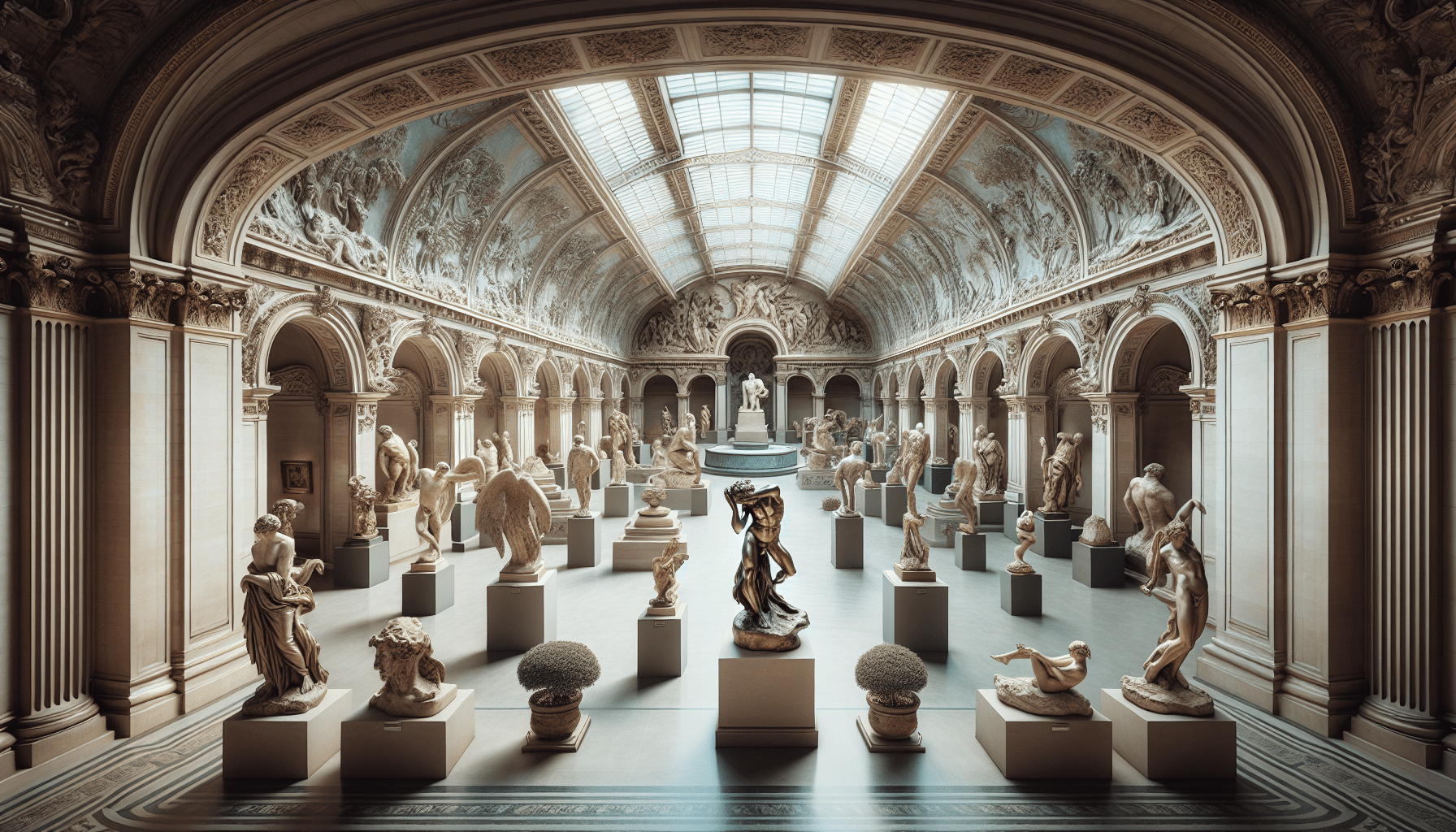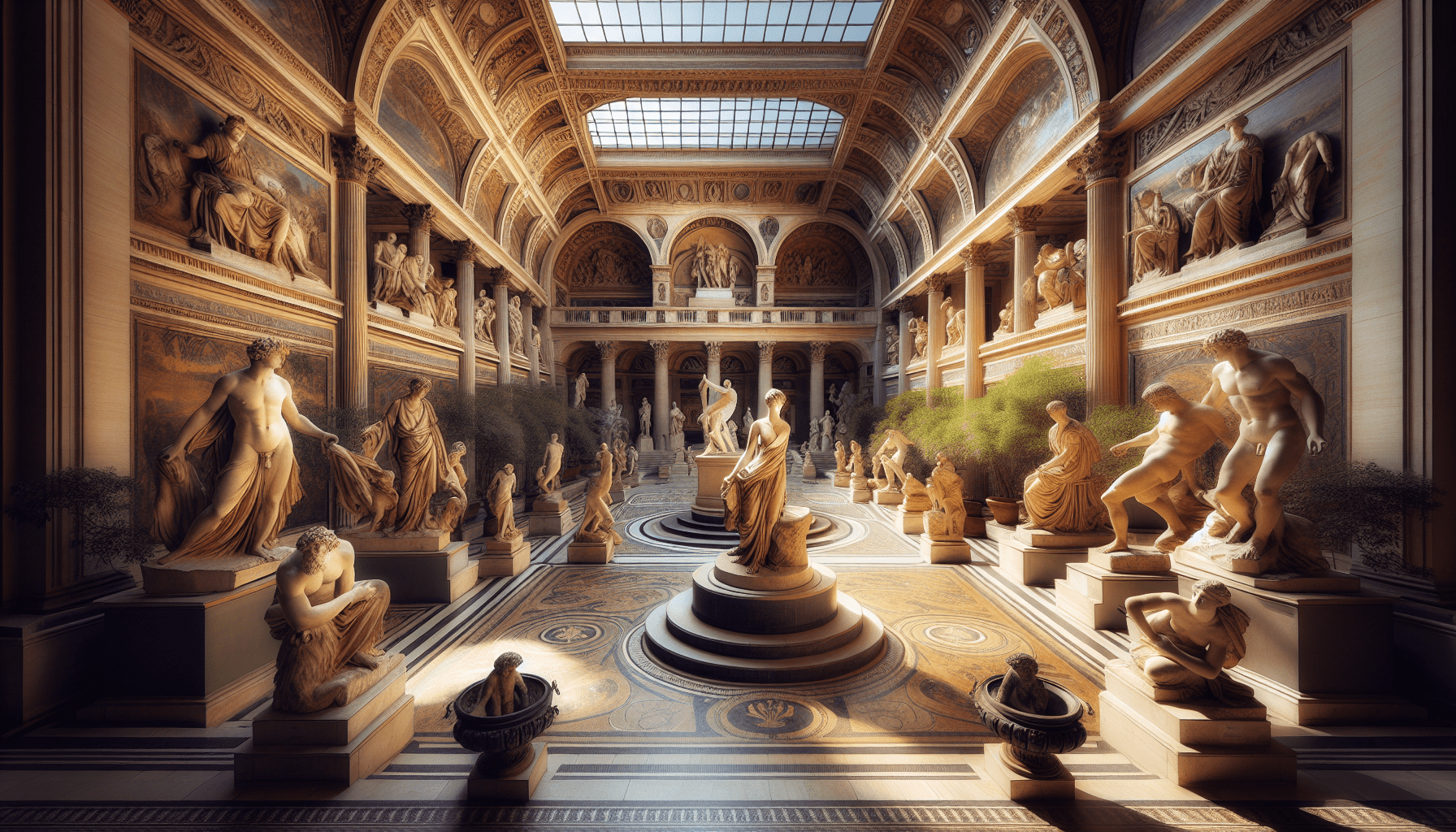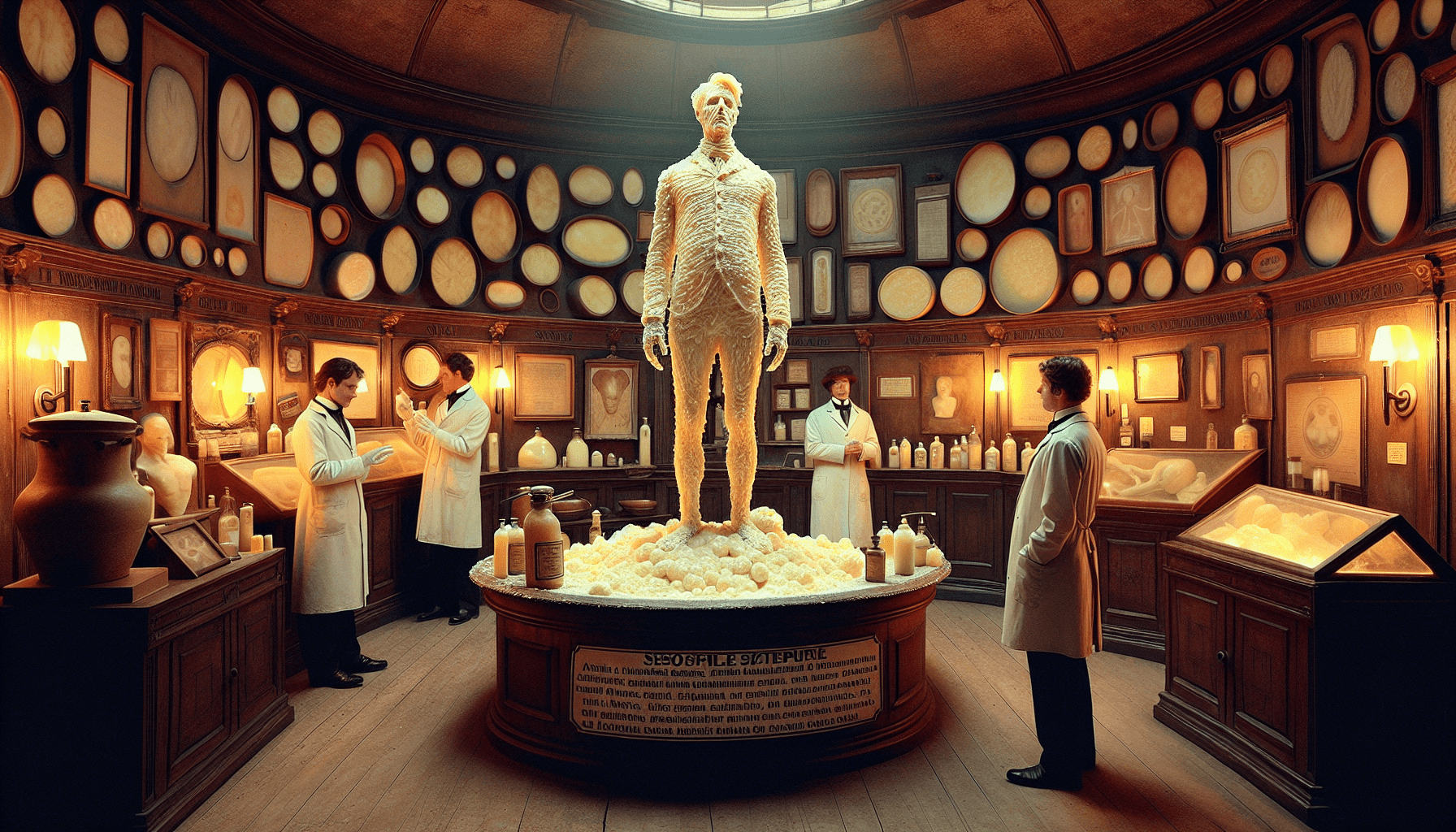Amazon Basics 21" Hardside Carry-On Luggage, Hardshell Suitcase With Wheels, Expandable For Up to 25% More Space, With Scratch-Resistant Surface, Four Multi-directional Wheels, Black
$63.99 (as of April 2, 2025 06:00 GMT +00:00 - More info)Visit Philadelphia’s iconic Rodin Museum and immerse yourself in the world-renowned sculptures of French artist Auguste Rodin. Located in a charming garden setting, this cultural gem showcases over 150 works, including his masterpiece, “The Thinker.” As you wander through the museum’s intimate galleries, you will be captivated by the profound emotions and intricate details captured in each sculpture. Whether you are an art enthusiast or simply seeking a moment of inspiration, the Rodin Museum promises a memorable and enriching experience for all.

About the Rodin Museum
History of the museum
The Rodin Museum, located in Philadelphia, is dedicated to the work of the renowned French sculptor Auguste Rodin. The museum first opened its doors to the public in 1929, making it one of the oldest museums in the city. It was established by Jules E. Mastbaum, a wealthy businessman and art collector, who was inspired by Rodin’s sculptures during a visit to Paris.
Location and hours of operation
The Rodin Museum is situated in the beautiful Fairmount neighborhood of Philadelphia, on the Benjamin Franklin Parkway. Its central location makes it easily accessible for both locals and tourists. The museum is open to the public six days a week, from Tuesday to Sunday. The opening hours are from 10:00 am to 5:00 pm, providing visitors with ample time to explore and appreciate the artwork.
Architecture and design
Apart from housing an impressive collection of sculptures, the Rodin Museum itself is a work of art. The building is modeled after the Hôtel Biron, where Rodin once lived and worked in Paris. The sleek and elegant Beaux-Arts style architecture adds to the grandeur of the museum. The interior features high ceilings and natural light that beautifully showcase the sculptures. The carefully designed layout ensures that the artworks can be admired from multiple angles, allowing visitors to fully appreciate the intricate details and craftsmanship.
Highlights of the Museum
The Thinker
One of the most iconic sculptures at the Rodin Museum is “The Thinker.” This monumental bronze statue depicts a man in a thoughtful pose, with his hand on his chin. It is considered by many as Rodin’s masterpiece and has become a symbol of intellectual and philosophical contemplation. Displayed prominently in the museum’s garden, “The Thinker” invites visitors to pause and reflect, making it a must-see for art enthusiasts and casual visitors alike.
The Gates of Hell
Another significant artwork at the museum is “The Gates of Hell,” which is a monumental sculptural group portraying various figures from Dante’s “Inferno.” This complex piece took Rodin many years to complete and showcases his mastery of capturing human emotion and movement. The Gates serve as a visual representation of the path from sin to redemption, making it a powerful and thought-provoking work.
Eternal Springtime
“Eternal Springtime” is a delicate and sensual sculpture that showcases Rodin’s ability to capture the tender and intimate moments between two lovers. This bronze piece portrays a couple locked in an embrace, frozen in a moment of eternal love and passion. The intricate details and the fluidity of the figures’ bodies create a sense of movement and romance, making it a captivating artwork that resonates with viewers.
The Burghers of Calais
“The Burghers of Calais” is another notable sculpture at the Rodin Museum. This piece tells the story of six men from the city of Calais who sacrificed themselves during the Hundred Years’ War. Rodin’s sculptures depict the anguish and determination of each individual, capturing their bravery and selflessness. The emotional depth conveyed by the sculptures makes “The Burghers of Calais” a profound and moving artwork.
Artworks by Rodin
Overview of Rodin’s style
Rodin is known for his innovative approach to sculpture, breaking away from the traditional standards of the time. His works are characterized by their realism, capturing the human form in its natural state, flaws and imperfections included. Rodin embraced the use of texture and movement in his sculptures, adding a sense of life and vitality to the otherwise static medium.
Sculptures influenced by classical art
Rodin drew inspiration from classical art, particularly the works of Michelangelo and ancient Greek sculptures. He admired the way these artists emphasized the human figure and its expression of emotion. Rodin incorporated these influences into his own work, creating sculptures that not only showcased the human body but also conveyed a range of emotions and narratives.
Emphasis on human emotions
One of the distinguishing features of Rodin’s sculptures is the emphasis on human emotions. He believed that the human figure was a vessel for expressing a wide range of feelings, and he sculpted with great sensitivity and attention to detail to convey those emotions. Whether it’s anguish, love, joy, or despair, Rodin’s sculptures evoke a strong emotional response from viewers.
Famous sculptures on display
In addition to the highlighted artworks mentioned earlier, the Rodin Museum exhibits many other famous sculptures by the artist. Some notable pieces include “The Kiss,” “The Age of Bronze,” and “The Hand of God.” Each sculpture has its own distinct style and narrative, offering visitors a comprehensive glimpse into the breadth and depth of Rodin’s artistic vision.
Guided Tours and Audio Guide
Benefits of guided tours
Taking a guided tour of the Rodin Museum can greatly enhance your visit. Knowledgeable guides provide valuable insights into the life and work of Rodin, allowing you to gain a deeper appreciation for the sculptures on display. They can share interesting anecdotes, historical context, and details about the artistic process, painting a more vivid picture of the artist’s world.
Availability of audio guides
For those who prefer a self-guided experience, audio guides are available at the museum. These devices provide a narrated tour that takes you through the different sections of the museum, offering informative commentary on the artworks. The audio guides allow you to explore at your own pace and delve into the details that interest you the most.
Languages offered in guided tours
Guided tours at the Rodin Museum are conducted in multiple languages to accommodate diverse visitors. English, French, Spanish, and German are among the commonly offered languages. This ensures that visitors from around the world can fully immerse themselves in the art and learn about Rodin’s legacy in a language they are comfortable with.

Events and Exhibitions
Temporary exhibitions
The Rodin Museum regularly hosts temporary exhibitions that showcase the work of contemporary artists, as well as thematic exhibitions related to Rodin’s art. These exhibitions provide a fresh perspective and allow visitors to explore different artistic styles and interpretations. By offering a diverse range of artistic experiences, the museum ensures that there is always something new and exciting to discover.
Special events
In addition to exhibitions, the Rodin Museum hosts special events throughout the year. These events can include artist talks, workshops, and performances inspired by Rodin’s artwork. Visitors have the opportunity to engage with the art in unique ways, gaining a deeper understanding of the creative process and its relevance to contemporary culture.
Educational programs
The Rodin Museum is committed to fostering a love for art and education. The museum offers a variety of educational programs for people of all ages, including school tours, workshops, and lectures. These programs strive to make art accessible and engaging, encouraging visitors to develop a deeper appreciation for sculpture and the artistic process.
The Garden and Outdoor Sculptures
Lush greenery and serene atmosphere
The Rodin Museum features a stunning garden that surrounds the building, providing a tranquil and picturesque setting for visitors. The lush greenery, beautiful flowers, and carefully designed landscaping create a peaceful atmosphere that complements the sculptures on display. The garden offers a welcome reprieve from the hustle and bustle of the city, allowing visitors to relax and immerse themselves in the art.
Significance of outdoor sculptures
The outdoor sculptures in the Rodin Museum’s garden play an integral role in the overall visitor experience. These sculptures were specifically selected to be displayed in an outdoor setting, allowing the natural elements to interact with the art. The changing light, weather, and seasons contribute to the ever-evolving ambiance, giving each sculpture a unique and dynamic presence.
Prominent sculptures in the garden
Among the notable outdoor sculptures is “The Gates of Hell,” which acts as a focal point in the garden. Other prominent works include “The Burghers of Calais” and “The Thinker.” These larger-than-life sculptures are strategically placed throughout the garden, creating a harmonious blend of nature and art.
Picnic areas and benches
For visitors looking to take a leisurely break or enjoy a meal surrounded by art, there are picnic areas and benches scattered throughout the garden. These designated spots provide the perfect opportunity to relax, soak in the beauty of the surroundings, and have a meaningful conversation about the artwork. Whether you bring your own picnic or simply want to sit and reflect, these spaces offer a peaceful retreat within the museum.
Visitor Amenities
Café and restaurant facilities
The Rodin Museum features a café and a restaurant that offer a range of dining options for visitors. The café provides light refreshments such as coffee, pastries, and sandwiches, allowing you to grab a quick bite before or after exploring the museum. The restaurant offers a more extensive menu with a focus on French cuisine, providing a delightful dining experience in an elegant setting.
Gift shop
Before leaving the museum, be sure to visit the gift shop, where you can find a variety of art-inspired items and souvenirs. From books and prints to jewelry and home decor, the shop offers a wide selection of unique and tasteful gifts for art enthusiasts. Purchasing a memento from the Rodin Museum allows you to bring a piece of the artistic experience home with you.
Accessibility features
The Rodin Museum is committed to making art accessible to all visitors. The building is equipped with ramps and elevators to ensure that people with mobility challenges can navigate the museum easily. There are also accessible restrooms available. The museum’s website provides detailed information on the accessibility features and services, allowing visitors to plan their visit accordingly.
Ticket Information and Discounts
General admission prices
The Rodin Museum offers general admission tickets at a reasonable price, making it accessible to a wide range of visitors. Adult tickets are typically priced between $7 and $10, with discounts available for seniors, students, and military personnel. The cost of admission grants visitors access to both the museum and the garden, allowing for a comprehensive experience of Rodin’s art.
Senior and student discounts
Senior citizens and students can take advantage of discounted tickets at the Rodin Museum. Valid identification or proof of status may be required at the time of purchase, so it’s important to bring the necessary documentation to claim the discounted rate. These discounts provide an opportunity for seniors and students to explore the world of art without breaking the bank.
Group rates and reservations
Groups of 10 or more people can benefit from discounted group rates at the Rodin Museum. It’s advisable to make advance reservations for group visits to ensure availability and streamline the check-in process. Group tours can be arranged to provide a more structured and informative experience, allowing groups to make the most of their visit.
Free admission days
The Rodin Museum offers free admission on certain days throughout the year. These designated free admission days provide an excellent opportunity for budget-conscious visitors or those who want to introduce their family and friends to art without incurring any cost. It’s worth checking the museum’s website or contacting their visitor services to find out the specific dates for free admission.
Nearby Attractions
Philadelphia Museum of Art
Located just a short distance from the Rodin Museum is the iconic Philadelphia Museum of Art. Known for its vast collection spanning various time periods and cultures, the Philadelphia Museum of Art offers a comprehensive art experience. Visitors can explore everything from European masterpieces to contemporary installations, making it a perfect complement to a visit to the Rodin Museum.
Benjamin Franklin Parkway
The Rodin Museum is situated on the Benjamin Franklin Parkway, a picturesque boulevard lined with beautiful green spaces, museums, and cultural institutions. Taking a leisurely stroll along the parkway allows you to admire the stunning architecture, enjoy outdoor sculptures, and soak in the vibrant atmosphere. The parkway serves as a hub of cultural activity, making it an excellent starting point for exploring Philadelphia’s art scene.
Franklin Institute
For those interested in science and technology, the Franklin Institute is a must-visit attraction in Philadelphia. This hands-on science museum offers interactive exhibits, immersive experiences, and educational programs for all ages. It’s a great place to learn about various scientific concepts, engage in thought-provoking activities, and have a fun-filled day with family and friends.
Barnes Foundation
Another notable institution in close proximity to the Rodin Museum is the Barnes Foundation. This art museum holds an impressive collection of European and American artwork, including works by renowned artists such as Picasso, Matisse, and Van Gogh. The Barnes Foundation is known for its unique presentation style, grouping artworks together in ensembles that encourage viewers to make connections and explore different artistic perspectives.
Tips for Visiting the Rodin Museum
Best time to visit
To fully enjoy your visit to the Rodin Museum, it’s advisable to plan your trip during weekdays, as weekends can be busier with higher visitor traffic. Arriving earlier in the day will allow you to beat the crowds and have more time to explore the museum and garden at your own pace. Additionally, visiting during the spring or fall months can provide pleasant weather and picturesque outdoor scenery.
Parking and public transportation
The Rodin Museum does not have its own parking lot, but there are several garages and street parking options available nearby. It’s important to be aware of parking restrictions and fees to avoid any inconvenience or penalties. Alternatively, public transportation is a convenient and eco-friendly option, with various bus routes and subway stations within walking distance of the museum.
Photography guidelines
Photography is allowed in the Rodin Museum, with certain guidelines in place to protect the artworks and the experience of other visitors. Flash photography is prohibited, as it can be harmful to the sculptures. Tripods and selfie sticks are also not allowed inside the museum. It’s important to be respectful of the artworks and fellow visitors while capturing your memories.
Recommended attire
The Rodin Museum does not enforce a strict dress code, but it’s recommended to wear comfortable shoes and clothing suitable for walking and exploring. As the museum is air-conditioned, it’s advisable to bring a light jacket or sweater, especially during the warmer months. Dressing in layers allows you to adjust your clothing according to the temperature inside the museum.
Etiquette and respect for artworks
Respecting the artworks and the museum environment is essential during your visit. It’s important to refrain from touching the sculptures, as the oils from our hands can cause damage. Additionally, maintaining a reasonable volume level and refraining from disruptive behavior ensures a peaceful and enjoyable experience for all visitors. Following the posted guidelines and instructions from museum staff will help foster a respectful and engaging atmosphere.






